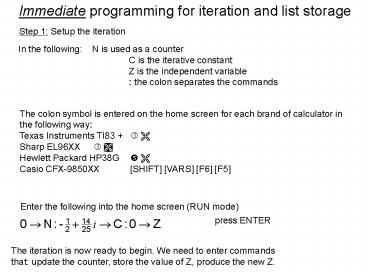Immediate programming for iteration and list storage
1 / 4
Title:
Immediate programming for iteration and list storage
Description:
Immediate programming for iteration and list storage. Step 1: ... Casio CFX-9850XX [SHIFT] [VARS] [F6] [F5] press ENTER. The iteration is now ready to begin. ... –
Number of Views:43
Avg rating:3.0/5.0
Title: Immediate programming for iteration and list storage
1
Immediate programming for iteration and list
storage
Step 1 Setup the iteration
In the following N is used as a counter C is
the iterative constant Z is the independent
variable the colon separates the commands
The colon symbol is entered on the home screen
for each brand of calculator in the following
way Texas Instruments TI83 ? ? Sharp
EL96XX ? ? Hewlett Packard HP38G ? ? Casio
CFX-9850XX SHIFT VARS F6 F5
Enter the following into the home screen (RUN
mode)
press ENTER
The iteration is now ready to begin. We need to
enter commands that update the counter, store
the value of Z, produce the new Z.
2
Immediate programming for iteration and list
storage
The iteration is now ready to begin. We need to
enter commands that update the counter, store
the value of Z, produce the new Z and display
the new values. Enter these commands.
press ENTER
As you now continue to press ENTER, the
calculator executes this second group of
commands, producing the new values, storing the
real and imaginary parts of Z in the lists, and
displaying them, and the current iteration
number, on the screen.
3
Plotting the iterates from the stored list data
With the each iterates real part stored in List1
and the imaginary part stored in in List2 we use
a scatter-plot to graph the sequence of iterates
on an Argand diagram.
The window settings are reasonably important here
and they will be calculator dependent. Most of
the Mandelbrot boundary lies within -2 x 0.5 by
-1 y 1. This plot is graphed on the TI83 -2.01
x 0.81 by -0.93 y 0.93
This plot exhibits 5-cycle behaviour.
4
Investigating different c-values.
Use this technique to investigate the behaviour
(convergent, cyclical or divergent) of the
quadratic iteration z z² c for the values of
c below. (Hint it will save time to edit the
commands already used rather than typing them in
again from scratch.) Dont forget to clear
Lists12 before you start iterating. ? For
convergent behaviour find the invariant
point. ? For cyclical behaviour identify which
member of the cycle lies in a lobe of the
Mandelbrot set ? For divergent behaviour, count
the number of iterations needed for z to
exceed 2.































